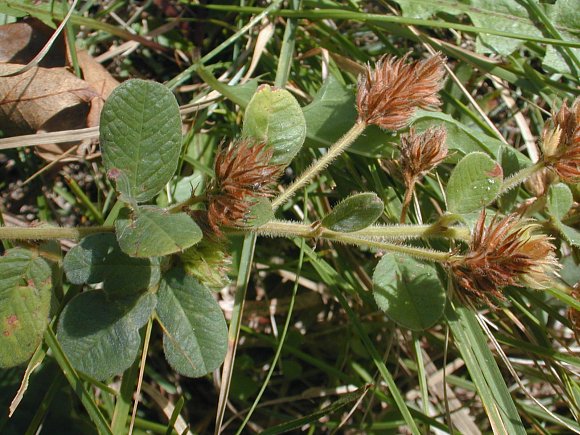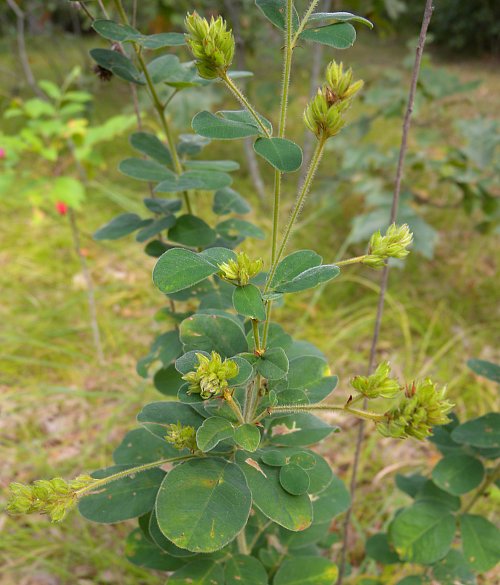Description: This perennial plant is 1½–3' tall and largely unbranched, except for several flowering stems toward the apex. The stems are covered with long white hairs. The alternate compound leaves are trifoliate. Each compound leaf has a short hairy petiole with a pair of narrow stipules about 1/10" (2.5 mm.) long at its base. The individual leaflets are up to 2" long and 1½" across. They are oval, oval-orbiculate, or obovate, and have smooth margins. Their upper surface is finely pubescent, while their lower surface is softly hairy. The upper stems terminate in rather short spike-like racemes of flowers about 1-3" long. The hairy flowering stalks (peduncles) are often longer than either the leaflets or the inflorescence. The spike-like racemes have whorls of flowers that are densely crowded together. Each flower is about 1/3" (8 mm.) long and cream-colored, usually with a purple spot at the base. It has a typical pea-like flower structure, consisting of a standard and keel. The calyx lobes are longer than the flowers. They are hairy, narrow, and taper to a sharp point, turning brown with maturity. This species of bush clover rarely produces cleistogamous flowers. The blooming period occurs during the late summer and lasts about 3 weeks. There is no noticeable floral scent. Each flower is replaced by a seedpod that is short, flat-sided, and pubescent, with its outer tip consisting of a short beak. This seedpod is about the same length or shorter than the calyx lobes. The root system consists of a taproot. This plant spreads by reseeding itself.

Cultivation:
The
preference is partial sun, mesic to dry conditions, and an acid soil
containing sand or rocky material. Full sunlight or light shade, and
more fertile soil are also tolerated. Hairy Bush Clover fixes nitrogen
in the soil.
Range & Habitat:
This species has an odd bifurcated distribution, occurring in NE and
southern Illinois, but hardly anywhere else in the state (see Distribution
Map). Hairy Bush Clover is an occasional plant in these
areas, where it is native. Habitats include upland
oak woodland that are rocky or sandy, oak savannas that are rocky or
sandy, and sandstone glades. In NE Illinois, this species occurs in
sandy areas that are dominated by Black Oaks, while in southern
Illinois it occurs in areas that are hilly and rocky. Occasional
wildfires are probably beneficial to this species as this opens up the
forest canopy.
Faunal Associations:
The flowers attract bees primarily, including bumblebees, Leaf-Cutting
bees, and Halictid bees. The short-tongued bee Calliopsis andreniformis
often visits the flowers of Lespedeza spp.
Butterflies may visit the flowers for nectar, but they are
non-pollinating. The foliage is eaten by the caterpillars of various
skippers and moths. This includes such skipper species as Thorybes
pylades (Northern Cloudywing), Thorybes bathyllus
(Southern Cloudywing), and Epargyreus clarus
(Silver-Spotted Skipper), and such moth species as Utetheisa
bella (Bella Moth), Ptichodis herbarum
(Common Ptichodis), and Dasylopha anguina
(Black-Spotted Prominent). The seeds are eaten by the Bobwhite Quail
and Wild Turkey, while the foliage is eaten by the Cottontail Rabbit
and White-Tailed Deer. The foliage is non-toxic and highly palatable to
mammalian herbivores.

Photographic
Location:
The photos were taken at a sandy savanna and a sandy path of the Hooper
Branch Savanna Nature Preserve in Iroquois County, Illinois. The
dominant tree in this area is Quercus
velutina
(Black Oak).
Comments:
Hairy Bush Clover is one of several Lespedeza spp.
that occur in Oak woodlands or savannas. This species is not very showy
as the small flowers are partially hidden by the long calyx lobes. It
can be distinguished from these other species by its cream-colored
flowers, unusually broad leaves, and very hairy stems. A distinguishing
characteristic are the long peduncles, which are often longer than the
leaflets and spike-like racemes. This can be readily observed in the
photographs. Other bush clovers, such as Lespedeza capitata
(Round-Headed Bush Clover), usually have shorter peduncles.